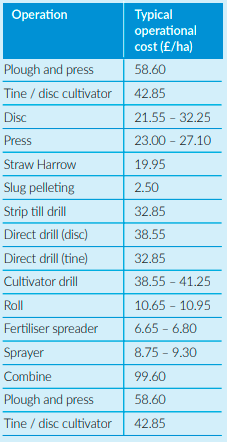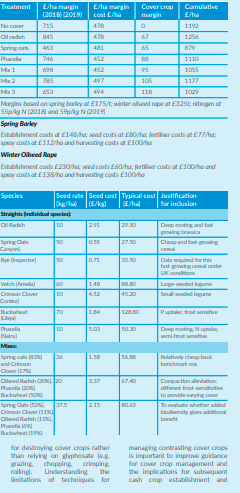AHDB’s Technical Knowledge Exchange Manager, Harry Henderson, takes a look at the results from the recently published Maxi Cover Crop research findings and discusses what lessons you can take-away for your farm system.

Cover crops. You’ve read the articles of untold benefits of soil restructuring, drainage improving nutrient building, weed suppressing, disease controlling, yield enhancing, resilience building, environment saving, superhero cover crops. You’ve seen the videos online of drills working in bonnet high cover crops without issue and crimper rolls seemingly doing away with agro-chemical control. It must be a no-brainer to get involved in cover crops.
But on the 11th May this year the AHDB issued a press release and a 111 page report of a 3-year cover crop trial with the standout comment being; Cover crops were associated with an average gross margin loss of £150/ha across two consecutive arable cash crops. How could this be? I phoned a couple of my colleagues and they said ‘It is the experience of many farmers starting out using cover crops’. Clearly, a further look into the report is necessary and this publication is the place to do it. Does the report have gaps? Sure. Does the report highlight real findings and put some realism into what is an ever-evolving story? Definitely.
So, the AHDB funded a three-year “Maxi Cover Crop” project, which aimed to maximise the potential agronomic, economic and ecological benefits from cover crops through investigating different cover crop options and crop management approaches.
In a recent survey of UK farmers, the most cited reasons for not growing cover crops were:
1. They did not fit with the current rotation
2. Expense
3. Difficulty of measuring their benefit to crop production.
The Maxi Cover Crop project has shown that:
• Early establishment (August rather than September) is important to maximise the benefits of cover crops, particularly to ensure good crop cover and nutrient recovery. Typically, the different cover crops yielded between 1 and 3 t/ha above ground biomass and took up between 30 and 50kg N/ha, although up to 90 kg/ha N was recovered following early establishment at one of the sites.
• Highest N recovery was achieved by using either species that were able to fix N from the atmosphere (i.e. clover and vetch) or establish good above or below ground biomass, early in the season (e.g. radish, phacelia and rye).
• Rye produced the largest root length early in the season. Phacelia also rooted well although the roots were slower to develop. By the time the cover crops were destroyed (February), phacelia had produced the greatest amount of roots, particularly in the topsoil, and it also had the narrowest roots, suggesting it explored more of the soil for a given root biomass compared to the other cover crop treatments. There was no relationship observed between the amount of cover crop rooting and rooting of the following spring cash crop.
• Soil structural improvement from a single year of cover cropping was difficult to detect. However, at two of the tramline trial sites with medium textured soils, penetration resistance, bulk density and visual structural scores were lower (i.e. ‘better’) where cover crops had been grown indicating improved soil structure and workability. Earthworm numbers were also increased where a five species mix (comprising phacelia, oats, oil radish, clover and buckwheat) had been grown.
• Cover cropping on heavy textured soils was shown that it can result in increased topsoil moisture content, probably as a result of the vegetative cover preventing evaporation from the soil surface.
• Late destruction and incorporation of a high cover crop biomass (< 1 week prior to drilling) resulted in poor seedbed conditions for the establishment of the following cash crop, which led to lower crop yields.
• Cereal cover crops (as a single species) should not be grown ahead of a spring cereal cash crop. At the experimental sites, spring barley establishment, rooting to depth and grain yields were all reduced following oat and rye cover crops. The reason for this is uncertain, but N immobilisation, and pest and pathogen carry-over (‘green bridge’) have been cited as possible causes.
• A buckwheat cover crop may enhance P availability to the subsequent cash crop. At the experimental sites, there was a trend for higher phosphorus concentrations in spring barley grain following a buckwheat cover crop compared to the control (volunteer/weeds). It is uncertain what the mechanism is for this, as rooting by the buckwheat and total above ground biomass production was low compared to the other species evaluated.
• A single year of cover cropping does not improve gross margins. Nearly all the cumulative (2 year) margins calculated across the sites (20 comparisons) showed a reduction in margin from growing a cover crop compared to no cover crop (ranging from + £64/ ha following oil radish on a clay loam to – £476/ha following a two species mix on a clay soil). The lower margins were caused by an absence of sufficient yield increases to compensate for the additional seed and establishment costs. The benefits from changes in soil physical properties or nutrient dynamics are unlikely to appear within the 2 years of the project so the longer-term use of cover crops over a full rotation (including more than one year of cover cropping) is required to fully assess the impact on margins. Moreover, non-tangible benefits such as improved water quality, erosion control and enhanced biodiversity should be considered as a wider public good.
Tackling that headline statement of £150/ha loss. The operation costs, while representative, are at the top end of where costs tend to be.

The Monitor Farm average for combining is £66/ha for example. And disc based direct drilling varies from £19 to £30/ha depending on how much land you cover with it. S,o operation costs used in the trial are 30% more than you’d hope to face.

As an illustration, at the Kneesall, Nott’s trial site, the spring oats had the lowest cumulative margin of £879/ha due to a yield reduction of 1.43 t/ha compared to control, (stubble and cereal re-growth) which may reflect the rotational conflict of growing a cereal after a cereal cover crop. The highest cumulative margin was from the oil radish which was £1256/ha, which reflected the higher spring barley yield and low seed costs compared to the other treatments. The control cumulative margin was £1192/ha. The cost of establishment of the cover crop ranged from £65/ ha (spring oats) to £118/ha (mix 3 – spring oats, crimson clover, oilseed radish, phacelia and buckwheat). It’s perhaps unfair to expect a cover crop to return on investment from yield improvement alone. Especially in year one. As we have realised at many a Monitor Farm meeting, building soil resilience is a career long objective and adopting cover crops should enable lower machine costs, much lower than used in the trials. Cover crops should also extend working windows and improve surface drainage, but again these are long term aspirations rather than quick fixes.
With all field trial work, while questions are answered, more questions are raised. That well-worn phrase ‘more research is needed’ certainly stands true in this case. And arguably a greater look into adopting cover crops into a system of changes on the farm, to lower cost, reduce reliance on inorganic solutions and improving overall farm resilience is needed.
Future research suggestions included:
• Understanding the fate of N recovered by cover crops – when this N is released and how much is released. The ability to predict mineralisation rates for different cover crop species grown on contrasting soil types in different agro climatic zones will improve fertiliser recommendations for subsequent cash crops.
• Evaluating alternative methods for destroying cover crops rather than relying on glyphosate (e.g. grazing, chopping, crimping, rolling). Understanding the limitations of techniques for managing contrasting cover crops is important to improve guidance for cover crop management and the implications for subsequent cash crop establishment and effects on soil properties and N supply.
• Evaluating the long-term (multiple cycles of cover cropping) benefits of cover crops. What are the benefits for soil organic matter, soil biology and associated soil properties.
• Quantifying the economics of growing cover crops and the potential income from livestock grazing or the reduction in inorganic nitrogen fertiliser application in the following cash crop.
• This study showed that rye and to lesser extent spring oats resulted in slower development of spring barley early in the season and lower yields at harvest. Further work is required to understand the cause of the cash crop yield reductions (e.g. nutrient availability, disease pressure, etc) and whether cover crop mixes can be developed that do not lead to reduced yields. This has implications for EFA’s which require cover crop mixes to include a cereal and non-cereal. • In this study, there was some evidence suggesting that buckwheat may enhance P availability to the following cash crop. However, further work is needed to understand the mechanism for this, and given the cost of buckwheat, how much of a cover crop mix needs to be buckwheat for this benefit to be achieved.
While there’s lots still to understand, it is a no-brainer that covered soil is good for farming, the environment and will pay dividends in the long term. So a longer term look into cover crops would the best as the next steps for research. All three AHDB Strategic Farms in Warwickshire, Suffolk and Fife, Scotland will address cover crops over their 6-year programme and incorporate them into each farms long term thinking. Make sure you check in either online with the results from these farms as they come through, or in due course, in person.
For further information on cover crops and to download the project report, scan the QR code below:

For further information on the Strategic Farms, visit: scan the QR code below:
